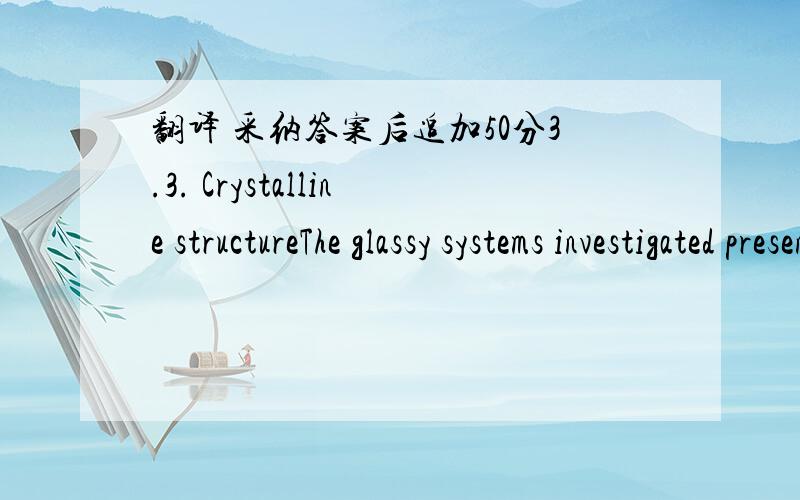翻译 采纳答案后追加50分3.3. Crystalline structureThe glassy systems investigated presented a crystalline phase after the thermal treatment, exception made for frit D. Figs. 9 and 10 show the XRD patterns, after sintering, for frits B and D,
来源:学生作业帮助网 编辑:作业帮 时间:2024/11/30 09:31:33

翻译 采纳答案后追加50分3.3. Crystalline structureThe glassy systems investigated presented a crystalline phase after the thermal treatment, exception made for frit D. Figs. 9 and 10 show the XRD patterns, after sintering, for frits B and D,
翻译 采纳答案后追加50分
3.3. Crystalline structure
The glassy systems investigated presented a crystalline phase after the thermal treatment, exception made for frit D. Figs. 9 and 10 show the XRD patterns, after sintering, for frits B and D, respectively. We can see there the amorphous structure of the raw frit D (0 8C). In the case of the raw frit B, as well as for raw frits C and E (patterns not shown here), a crystalline structure already existed in the raw frit. The peaks at 38,5 and 44,88 2u refer to the aluminium in the sample support.
In the case of frit A, the results have shown that it remains amorphous until 800 8C and only after that it starts to form anorthite and diopside. At 920 8C, the sample exhibits a high amount of crystalline phase but, at 1050 8C, it is possible to notice a small decrease of the anorthite peak intensity, benefiting the growth of diopside. The final product also contains residual gehlenite.
The final product X-ray patterns for frit B are given in Fig. 11. It has been shown previously, in Fig. 9, that the raw sample contains spinel. Between 850 and 940 8C (first exothermic peak), the frit devitrificates leading to the formation of spodumene and a magnesium aluminosilicate (MgAl2- Si3O10). For this temperature, cordierite also crystallizes though in a very small amount. During the second crystallization peak, XRD continues to detect spodumene indicating, however, the additional production of cordierite and indialite which are, now, the main crystalline phases. Therefore, MgAl2Si3O10, formed during the first peak, was converted to form cordierite and indialite.
TheXRDresults for frit C showthat the rawmaterial contains vestigial celsian and baric orthoclase (K,Ba)(Si,Al)4O8. Celsian continues to form during the exothermic event (810–860 8C) becoming the principal crystalline structure. Banalsite formation is also detected during the exothermic peak.
翻译 采纳答案后追加50分3.3. Crystalline structureThe glassy systems investigated presented a crystalline phase after the thermal treatment, exception made for frit D. Figs. 9 and 10 show the XRD patterns, after sintering, for frits B and D,
3.3 晶体结构
经热处理后,除了玻璃样本D,该种玻璃结构都呈现晶体化的痕迹.图9和10分别为B、D玻璃样本在烧结后的XRD分析图.从图中我们可以看到D号样本在8摄氏度下的无组织结构.而对于样本B,C,E(图片欠奉),处理前就已经存在晶体结构.在38.5和44.88 2U两处的峰值表示样本中的铝含量.
样本A的无组织状态直到温度达到800.8摄氏度才被破坏.之后该样本中开始出现钙长石(anorthite)和透辉石(anorthite).在920.8摄氏度下样本中开始出现大面积结晶状态.但在1050.8摄氏度时,我们看到钙长石含量的峰值有所下降,并造成透辉石含量上升.样本的最终产品中也含有钙黄长石的残余.
从图11中我们可以看到样本B的最终产品的X光图.我们从图9中可以看到,样本在处理前已经含有尖晶石成分.在850到940.8摄氏度之间(即第一个放热高峰),样本中的玻璃结构被破坏,从而导致锂辉石(spodumene)以及镁铝矽酸盐(MgAl2- Si3O10)的形成.在此温度下,堇青石(cordierite)也开始结晶化,尽管幅度很小.在第2个结晶化高峰间,XRD分析显示锂辉石(spodumene)仍然存在,但主要的结晶态为额外产生的堇青石(cordierite)和印度石(indialite).由此可见,第一个高峰区间产生的镁铝矽酸盐(MgAl2Si3O10)转化形成了堇青石和印度石.
样本C的XRD分析结果显示该样本中含有:钡长石的不完全形态以及含钡的正长石(K,Ba)(Si,Al)4O8.钡长石在810到860.8摄氏度间放热时仍然继续产生,并成为样品中主要的晶体结构.在上述放热区间,钡钠长石(Banalsite)也有一定程度的形成.
翻的术语可能有些偏差.不过可以保证语法通顺了.
段落与原文一一对应.
3.3. 水晶结构
被调查的玻璃状系统在热量治疗以后提出了一个水晶阶段, 为玻璃料做的例外D。 Figs. 9和10显示XRD样式, 在焊接以后, 为玻璃料B和D, 分别。 我们能看那里未加工的玻璃料D (0 8C)的无定形结构。 在未加工的玻璃料B情况下, 并且为未加工的玻璃料C和E (这里没显示的样式), 一个水晶结构已经存在了于未加工的玻璃料。 峰顶在38,5和44,88 2u在样...
全部展开
3.3. 水晶结构
被调查的玻璃状系统在热量治疗以后提出了一个水晶阶段, 为玻璃料做的例外D。 Figs. 9和10显示XRD样式, 在焊接以后, 为玻璃料B和D, 分别。 我们能看那里未加工的玻璃料D (0 8C)的无定形结构。 在未加工的玻璃料B情况下, 并且为未加工的玻璃料C和E (这里没显示的样式), 一个水晶结构已经存在了于未加工的玻璃料。 峰顶在38,5和44,88 2u在样品支持提到铝。
在玻璃料A情况下, 结果表示,它保持无定形直到800 8C,并且在那之后它开始形成钙长石和diopside。 在920 8C, 样品陈列一个金额上限水晶阶段,但, 在1050 8C, 注意钙长石高峰强度的小减退是可能的, 有益于diopside成长。 最终产品也包含残余的gehlenite。
最终产品X-射线样式为玻璃料B被给在。 11. 它早先显示了, 在。 9, 未加工的样品包含尖晶石。 在850和940 8C (第一个放热峰顶)之间, 导致spodumene和镁aluminosilicate (MgAl2- Si3O10)的形成的玻璃料devitrificates。 为这个温度, 堇青石在非常少量虽则也结晶。 在第二个结晶峰顶期间, XRD继续查出spodumene表明, 然而, 是堇青石的另外的生产和indialite, 现在, 主要水晶阶段。 所以, MgAl2Si3O10, 在第一个峰顶期间,形成, 被转换了成形式堇青石和indialite。
TheXRDresults为玻璃料C showthat原料包含痕迹celsian和baric orthoclase (K,Ba) (Si,Al) 4O8。 Celsian继续形成在放热事件(810-860 8C)期间成为主要水晶结构。 在放热峰顶期间, Banalsite形成也被查出。
追加哦!
收起